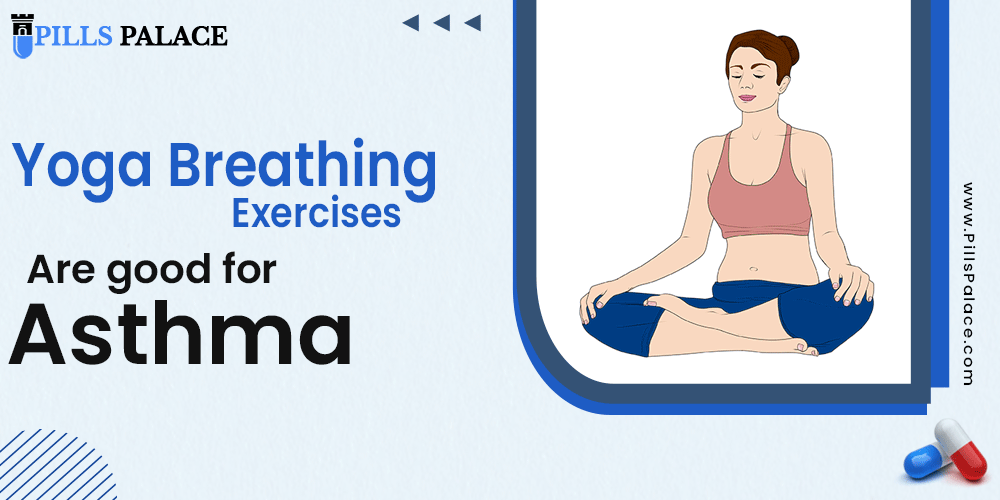Yoga breathing exercises are good for asthma
Inflammation of the lungs’ airways is a typical symptom of asthma. For those who are diagnosed with asthma, it is imperative that they understand how it may make breathing difficult and cause a slew of other distressing symptoms, such as wheezing and coughing.
You can’t get rid of asthma symptoms entirely, but there are drugs that may help you cope with the symptoms.
Breathing exercises may assist asthmatics to improve their quality of life by boosting immunity and strengthening respiratory muscles, according to recent research. The shallow and regulated breathing of breathing exercises for asthma may actually ease symptoms and reduce the need for preventative medicines…
Asthma sufferers are advised to do what breathing exercises? You can also use Asthalin Inhaler USA. If you suffer from asthma attacks, the following breathing exercises for asthma advocated by physicians and experts should be given a go.
Asthma sufferers should do deep breathing exercises to stay healthy.
Your lungs may benefit from breathing exercises. Medications such as inhalers are administered to individuals with asthma in order to open up their airways and enhance their ability to breathe.
Asthma sufferers may also benefit from breathing exercises, which have been shown to enhance breathing and quality of life, according to a variety of studies. There are several breathing strategies that are especially beneficial to asthmatics. Retraining one’s breathing may be aided by some of the exercises while strengthening the respiratory muscles and increasing rib cage flexibility are the primary goals of others.
Patients with asthma are typically prescribed breathing exercises by their doctor or asthma clinic. Always have a professional show you the breathing exercises before you try them on your own.
Breathing via the diaphragm
Diaphragmatic breathing strengthens your diaphragm, a dome-shaped muscle barrier that separates the belly and thorax and aids in breathing. Breathing more efficiently is made easier by this simple and straightforward method.
Diaphragmatic Breathing Techniques: What You Need to Know
You should be able to comfortably lie on your back with your legs bent slightly. Place a cushion between your knees to support your weight.
Aim to keep your chest steady while taking deep breaths in.
Slowly, through pursed lips, exhale.
Work on your inhalation and exhalation technique until you can do it without moving your chest.
Nasal Breathing
Breathing via the nose is known as nasal breathing. Asthma sufferers should use this breathing technique instead of mouth breathing, which has been related to the worsening of their symptoms. As a result, the discomforting symptoms may be alleviated due to the increased humidity and warmth in the air.
Nasal Breathing consists of the following steps:
- Sit with your legs crossed and feet flat on the floor.
- Then, raise your left hand all the way up so that it touches your nose.
- Method of Papworth
The Papworth approach, which dates back to the 1960s, incorporates a wide range of breathing techniques and relaxation methods into one. The technique teaches you to breathe slowly and steadily from the diaphragm and the nostrils. Your breathing will not be altered since it teaches you how to deal with stress. Asthma sufferers may benefit from using this method to enhance their quality of life and alleviate their breathing issues. People with moderate forms of asthma, such as mouth breathing and fast breathing, may benefit from it, according to current research. Patients with more severe asthma, sometimes brought on by allergens and the cold, may find it counterproductive.
- Repeat this cycle 3 to 5 times.
- Inhalation of Buteyko/ Betnesol
Since the 1950s, this method has been in use. Hyperventilation is a common symptom of asthma, and it occurs when a person breathes more quicker and deeper than normal. That’s why Buteyko breathing is frequently suggested for those with asthma — rapid breathing may aggravate symptoms. You may train yourself to breathe more slowly by using this method.
To what extent does Buteyko breathe –
- On a comfy chair, sit up straight and straighten your back.
- As you inhale, let go of your abdominal and chest muscles, allowing them to soften. Breathe in and out quickly and deeply.
- Slowly exhale until you can no longer feel any air in your lungs.
- Breathing with a Pursed Lip.
Asthma sufferers can find great relief from their symptoms by employing this specific breathing technique. Using this method may help you expel more air from your lungs, making it simpler for you to breathe. Asthma patients who are having trouble breathing can benefit greatly from this exercise.
Pursed-Lip Breathing may be done by following these steps:
- Inhale slowly and steadily via your nose, your lips firmly shut.
- Yin Yoga
Yoga has a long list of health benefits, but did you know that one of them is a reduction in the frequency and severity of asthma attacks? Study after study shows that regular yoga practice may minimise the requirement for an inhaler by 43% if practised consistently. Asthma sufferers might benefit from a variety of yoga poses that emphasise deep breathing exercises.
Asthma-Relieving Yoga Poses —
- In order to avoid an asthma attack, you should do a half-twist on your half-spinal twist.
- One of the finest breathing exercises for asthma sufferers is the Bridge Pose yoga pose. Improved digestion and reduced thyroid issues are just some of the ways it helps you feel more balanced.
- Known as Bhujangasana or Cobra Pose, this is another exercise that may help those with asthma. It is shown that the cobra stance enhances the body’s ability to transport oxygen and blood throughout it. Asthma symptoms may be alleviated by opening up the chest and clearing the airway to the lungs. You can buy Betnesol online.

